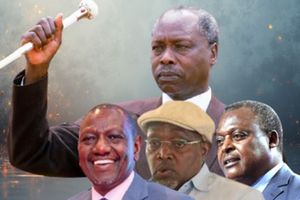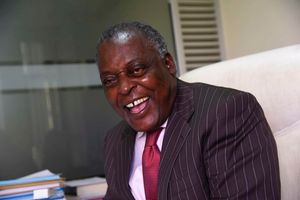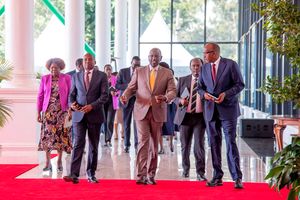Premium
Ten-year-old puzzle that was Charterhouse Bank

The then Finance Minister Amos Kimunya (right) is grilled on the Charterhouse Bank saga by the Parliamentary Select Committee on Finance at Parliament Buildings in Nairobi on October 7, 2010. PHOTO | STEPHEN MUDIARI | NATION MEDIA GROUP
What you need to know:
- Charterhouse Bank not only housed golden boys of the stock market but was also deeply involved in money laundering and other types of banking fraud.
- Some customers would routinely borrow as much as 20 times the cash they held and transact tens of millions of shillings into nameless accounts.
Ten years ago this month, the Central Bank of Kenya took over a little-known bank whose main branch was on the 7th floor of Nairobi’s Longonot Place; an odd place.
A battery of journalists dashed there eager to witness the takeover. It was a Friday morning, June 23, 2006. Out in the corridors with us was one of the bank’s directors, a tense Sanjay Shah who also owned Nairobi’s Kingsway Motors. I still remember his flowery tie hanging well below the belt as he made tens of frantic calls to anyone who cared to listen. His family’s business empire was hanging in the balance.
We all peeped to see what was happening inside. A one-page notice had been pasted on the entrance announcing that Miss Rose Detho, then assistant director at CBK, had taken over as receiver manager.
Charterhouse was not an ordinary bank. It not only housed golden boys of the stock market but was also deeply involved in money laundering and other types of banking fraud. Here, some customers would routinely borrow as much as 20 times the cash they held and transact tens of millions of shillings into nameless accounts.
A regular inspection had found that the bank had lent both Nakumatt Holdings Limited and Triton Petroleum Limited in excess of the single borrower limit of 25 per cent of its core capital. It was also found to be involved in insider lending without security above the prescribed limit of 20 per cent of its core capital. Of all the banks that have collapsed in the history of banking in Kenya, Charterhouse was in a class of its own. Still, it has no known competitor to that record.
This sanctuary of banking sins, still fighting to be re-opened, had managed to hide its crafty customers behind the façade of its bank registration certificate. As Central Bank would later find out, Charterhouse was a money-laundering mask; a bank run by financial freewheelers. With time, that mask, had become its face thanks to a collective madness that had penetrated the once hallowed financial market.
The banking mask was first discovered in 2003, three years before the takeover by Central Bank, when the institution hired an internal auditor from Barclays Bank. In the course of his duties, the new auditor, Mr Peter Odhiambo, noticed several irregularities including suspicious transactions in some accounts that lacked customer identification information.
In the banking world, this was simply, irregular since know-your-customer, a due diligence standard, was mandatory.
Meticulously, Odhiambo collected the information and handed it over to the Kenya Revenue Authority and to the then Kenya Anti-Corruption Commission. It was a massive creepy dossier and thereafter, he started receiving threatening calls. He shared the dossier with some US embassy officials and sought protection, according to a cache of confidential documents on Kenya released by the whistleblower website, Wikileaks.
Unlike other banks, Charterhouse was not facing liquidity problems.
Started in 1996, the bank had taken over operations of Middle East Kenya Finance Limited and quickly opened branches in Nairobi, Kisumu and Mombasa. The branches were located inside Nakumatt Supermarkets, an associate of the bank through common shareholding, according to a Central Bank report.
The bank was started as a family business and apart from Nakumatt, it shared directors with Kingsway Group via the parent holding company Ram Trust. The directors were Manish Shah, Manoj Shah, Artur Shah, and Sanjay Shah.
Ram Trust was named after the father of Kingsway Tyres, the late Ramniklal P. Shah—commonly known as Ram—who in 1962 opened a small shop on the then Kingsway road (now University Way) to sell tyres.
The small retail shop would subsequently balloon to become a multi-million shilling empire that is today known as Kingsway Group, a conglomeration of seven companies including Kingsway Tyres, Kingsway Motors, Charter House Bank, The Village Market, Kingsway Investments, Strobe Systems, Creative Innovations, Growth Management and Michelin Tyre Expert Centre.
By the time it was closed Ram Trust was thought to own 43.8 per cent of Charterhouse Bank but further investigations found that Manoj Shah and his brothers owned more than 54 per cent shareholding. Thus, according to a CBK report the bank had knowingly concealed the ownership. The banking Act restricts ownership by a party to a maximum of 25 per cent.
Charterhouse shareholding was a conundrum. Ram Trust was registered offshore in the billionaire tax haven of Liechtenstein, the world’s sixth smallest country known for its medieval castles, alpine chalets, villages and banking secrets. The haven was favoured by billionaires to stash the holding companies and investment entities that control their assets.
It was here that brothers Sanjay, Manoj and Manish appointed First Advisory Trust as their offshore trustees. This trust registered another shell company in British Virginia, Proudview Investments, which owned 21.7 per cent of Charterhouse Bank. Another company, Foreman Corporation, was registered in the Caribbean nation of Belize, known for its provision of secrecy services, and it also owned 21.74 shareholding of Charterhouse Bank.
The bank was also witnessing large inward and outward telegraphic transfers “to and from sources that could not be ascertained” according to records filed in court.
One of the most notable was a Sh2 billion transfer that was credited to Crucial Properties Limited in January 2001—a company owned by Nairobi businessman Humphrey Kariuki.
The transfer of the money to Charterhouse Bank raised the attention of the local police and the US Federal Bureau of Investigations after it was wired from Liechtenstein. Central Bank had moved fast and on January 30, 2001 it had frozen the Crucial Properties’ account demanding more information on where the money had come from.
Mr Kariuki, who was then running Green Corner Restaurant, an ordinary eatery in Nairobi’s Tumaini House, told the media that the unusually large transfer was legitimate and was part of a $150 million (Sh11 billion) package the company negotiated with international lenders to be invested in Kenya.
Available documents indicated that Crucial Properties was registered in 1996 but the firm remained dormant until 2000 when its directors informed Charterhouse Bank in writing that they were expecting some money from Temuco Foundation. After the CBK froze the account, Kariuki went to the High Court and he was allowed to withdraw Sh300 million. But the anti-narcotics police obtained an order that froze the accounts again. They told the court they were working with the FBI.
They also blocked an account held by Mr Kariuki’s lawyer, Mr Kariuki Muigua, where the Sh300 million had been transferred. An affidavit presented to court by Amos Tebeny of the anti-narcotics unit said they were investigating a drugs offence.
In his affidavit, Mr Kariuki said he instructed his lawyers in New Jersey to transfer the money from Temuco Foundation in New Jersey to ABN AMRO in the US, which was a correspondent bank for Charterhouse in Nairobi. He said the transfer was entirely legitimate. Mr Kariuki vowed to fight the money laundering suspicion and on May 10, 2001, Justice Samuel Oguk lifted the freezing orders allowing Mr Kariuki to withdraw the money. Before the Attorney General could appeal the order, Mr Kariuki withdrew Sh1.6 billion within hours and only Sh15.6 million was left in the account. Justice Oguk later refused to order investigations into the withdrawal blaming AG Amos Wako for delay in presenting his application to court. The Central Bank and police chase had reached a dead end!
A statutory management report said it found correspondence that showed the bank’s managing director regularly drafted letters on behalf of Tusker Mattresses and Creative Innovations—companies associated with the family—guiding them on how to correspond to KRA and Kenya Anti-Corruption Commission on tax demands.
Actually, when Central Bank governor Dr Andrew Mullei initiated investigations into the bank, the investigators found that the bank and well-known companies associated with it could have been costing the country more than Sh6 billion ($83.3 million) a year in tax evasion.
“Preliminary evidence appears to indicate the evasion of taxes is facilitated by the involvement of six companies. Two offshore companies directly related to the directors of the bank, while four are associated offshore companies—two in Italy, one in UK and the other in Dubai,” said the report.
It was also found that these companies acted as conduits of business transactions and funds transfers to the ultimate recipients. The idea was to mask and scuttle the trail of funds to the intended end beneficiaries.
With that, Dr Mullei wanted action taken against the bank. On March 20, 2006 he wrote to the then minister of Finance Amos Kimunya, recommending the revocation of Charterhouse Bank’s licence over what he said was the bank’s involvement in money laundering and tax evasion. Mullei said his recommendation was as a result of a detailed investigation of the bank that had uncovered illegal activities including significant tax evasion running into billions of shillings. It was Sanjay who sprang to the scene and dismissed Dr Mullei’s accusations and defended the bank. Two days later, Dr Mullei was suspended as CBK governor and hauled to court to face “abuse of office charges” for allegedly giving his son a contract to investigate the bank.
It was during that case that the acting CBK governor, Jacinta Mwatela, dropped the bombshell.
“This is not a bank and it should be closed,” she said.
The matter was also taken over by the departmental Committee on Finance, Planning, Trade and Tourism chaired by then Finance assistant minister Dr Oburu Oginga. The committee after taking four months to investigate the bank recommended its reopening. Although a report was tabled in the House on October 12, 2006 it was never debated and its recommendations were not adopted.
At one point, Parliament had threatened to censure the Governor for not reopening the bank, in what experts thought was overstepping its mandate.
During the grilling that took place in Parliament, Sanjay was put to task: “Did you at any time try to bribe any member of the Finance committee of Parliament?” asked Mr Jakoyo Midiwo in a committee chaired by Nambale MP Chris Okemo. Which Sanjay replied: “To date, there is no bribe that I have paid”.
This was at a time when a PriceWaterhouseCoopers report indicated that 839 accounts (representing 217 relationships) lacked opening forms or customer instructions despite some of the accounts handling billions of shillings in transactions.
Although there were allegations that Dr Mullei had been removed because of his queries on Charterhouse, Kimunya told Parliament the charging of the governor and his subsequent suspension was based on specific charges “and had absolutely nothing to do with his stand on Charterhouse Bank”.
That might never be known.
Kimunya would say that on March 20, 2006, he had directed CBK to send a team to Charterhouse to verify its status and update on a previous 2004 report. This 2004 report was leaked in Parliament and according to Kimunya he “regrettably approved” the appointment of a statutory manager.
There were several attempts by businessman John Harun Mwau, who had accounts in the bank, to use the floor of the House to get the 2007 report. He was told that “there are still areas that have not been properly addressed”.
But even with pressure from Parliament and some powerful customers, Charterhouse remains closed. In a 2010 petition to Parliament, 35 depositors of Charterhouse Bank stated there was no genuine and justifiable reason to continue causing them grave hardship, psychological torture, and degrading treatment by denying them access to their hard-earned deposits.
Ten years later, a bank that operated accounts without specific mandates and where accounts were opened and closed within a short span of time remains closed. It remains a case study on how not to run a bank. It was a syndicate and a 10-year-old puzzle.
The writer is acting editor, investigations and special projects; [email protected] @johnkamau1.





